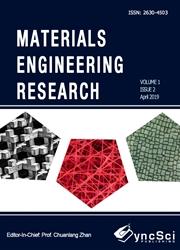Load-induced local phase transformation and modulus of shape memory alloys under spherical indentation by finite element method
引用次数: 0
Abstract
Shape memory alloys are a unique class of materials that are capable of large reversible deformations under external stimuli such as stress or temperature. The present study examines the phase transformations and mechanical responses of NiTi and NiTiHf shape memory alloys under the loading of a spherical indenter by using a finite element model. It is found that the indentation unloading curves exhibit distinct changes in slopes due to the reversible phase transformations in the SMAs. The normalized contact stiffness (F/S2) of the SMAs varies with the indentation load (depth) as opposed to being constant for conventional single-phase materials. The load-induced phase transformation that occurred under the spherical indenter was simulated numerically. It is observed that the phase transformation phenomenon in the SMA induced by an indentation load is distinctly different from that induced by a uniaxial load. A pointed indenter produces a localized deformation, resulting in a stress (load) gradient in the specimen. As a result, the transformation of phases in SMAs induced by an indenter can only be partially completed. The overall modulus of the SMAs varies continuously with the indentation load (depth) as the average volumetric fraction of the martensite phase varies. For NiTi (Ea > Em), the modulus decreases with the depth, while for NiTiHf (Ea < Em), the modulus increases with the depth. The predicted young modules during indentation modeling agree well with experimental results. Finally, the phase transformation of the SMAs under the indenter is not affected by the post-yield behavior of the materials.球形压痕下形状记忆合金载荷诱导局部相变及模量的有限元分析
形状记忆合金是一类独特的材料,能够在应力或温度等外部刺激下发生大的可逆变形。本文采用有限元模型研究了球形压头载荷下NiTi和NiTiHf形状记忆合金的相变和力学响应。结果表明,由于sma的可逆相变,压痕卸载曲线的斜率发生了明显的变化。sma的归一化接触刚度(F/S2)随压痕载荷(深度)的变化而变化,而传统单相材料的归一化接触刚度是恒定的。数值模拟了球形压头下载荷诱导的相变过程。观察到压痕载荷诱导的SMA相变现象与单轴载荷诱导的相变现象明显不同。尖压头产生局部变形,导致试样中的应力(载荷)梯度。因此,由压头诱导的sma中相的转变只能部分完成。sma的总模量随压痕载荷(深度)和马氏体相平均体积分数的变化而连续变化。对于NiTi (Ea < Em),模量随深度的增加而减小,而对于NiTiHf (Ea < Em),模量随深度的增加而增大。压痕模型预测的年轻模量与实验结果吻合较好。最后,压头下sma的相变不受材料屈服后行为的影响。
本文章由计算机程序翻译,如有差异,请以英文原文为准。
求助全文
约1分钟内获得全文
求助全文

 求助内容:
求助内容: 应助结果提醒方式:
应助结果提醒方式:


